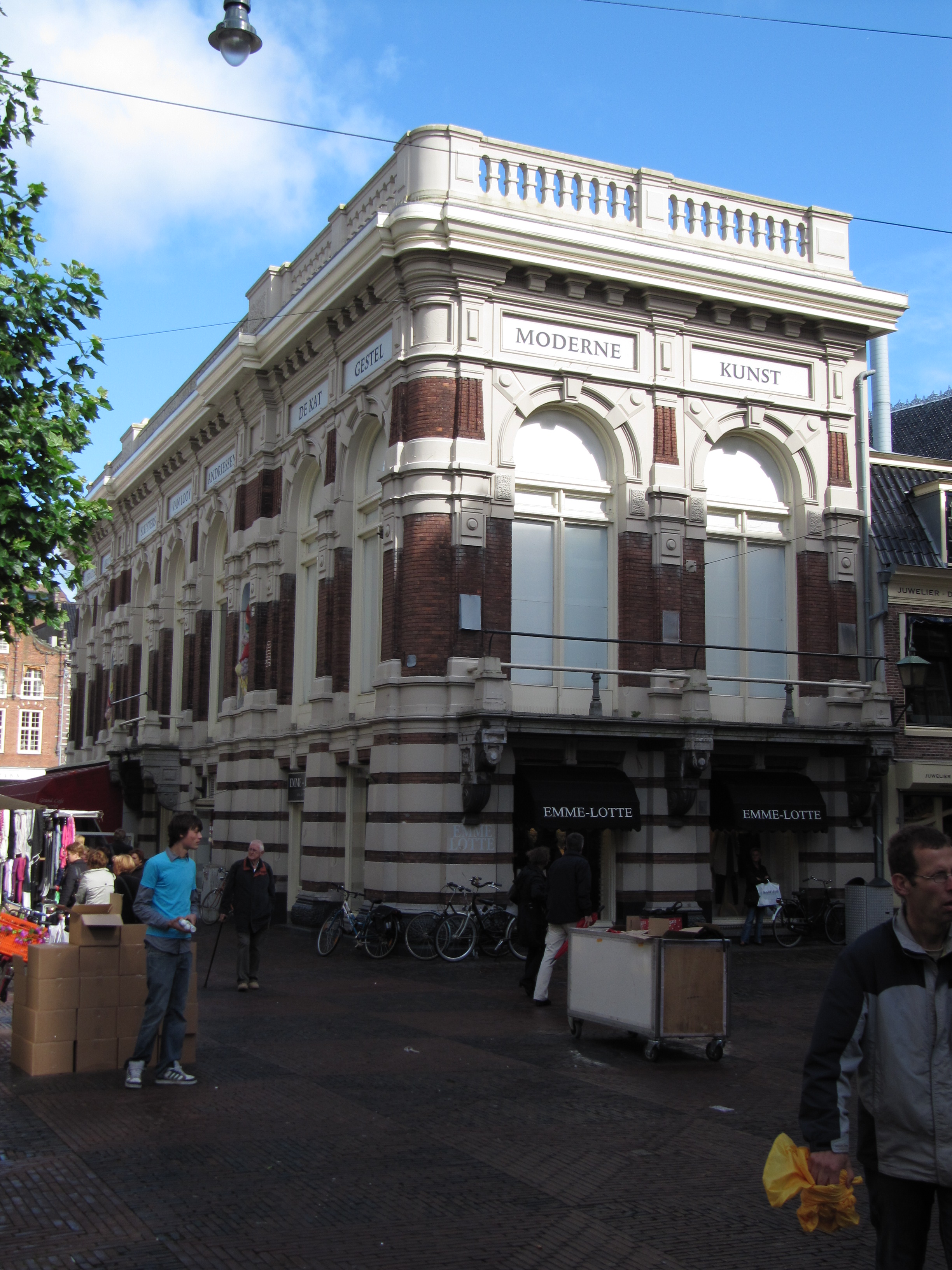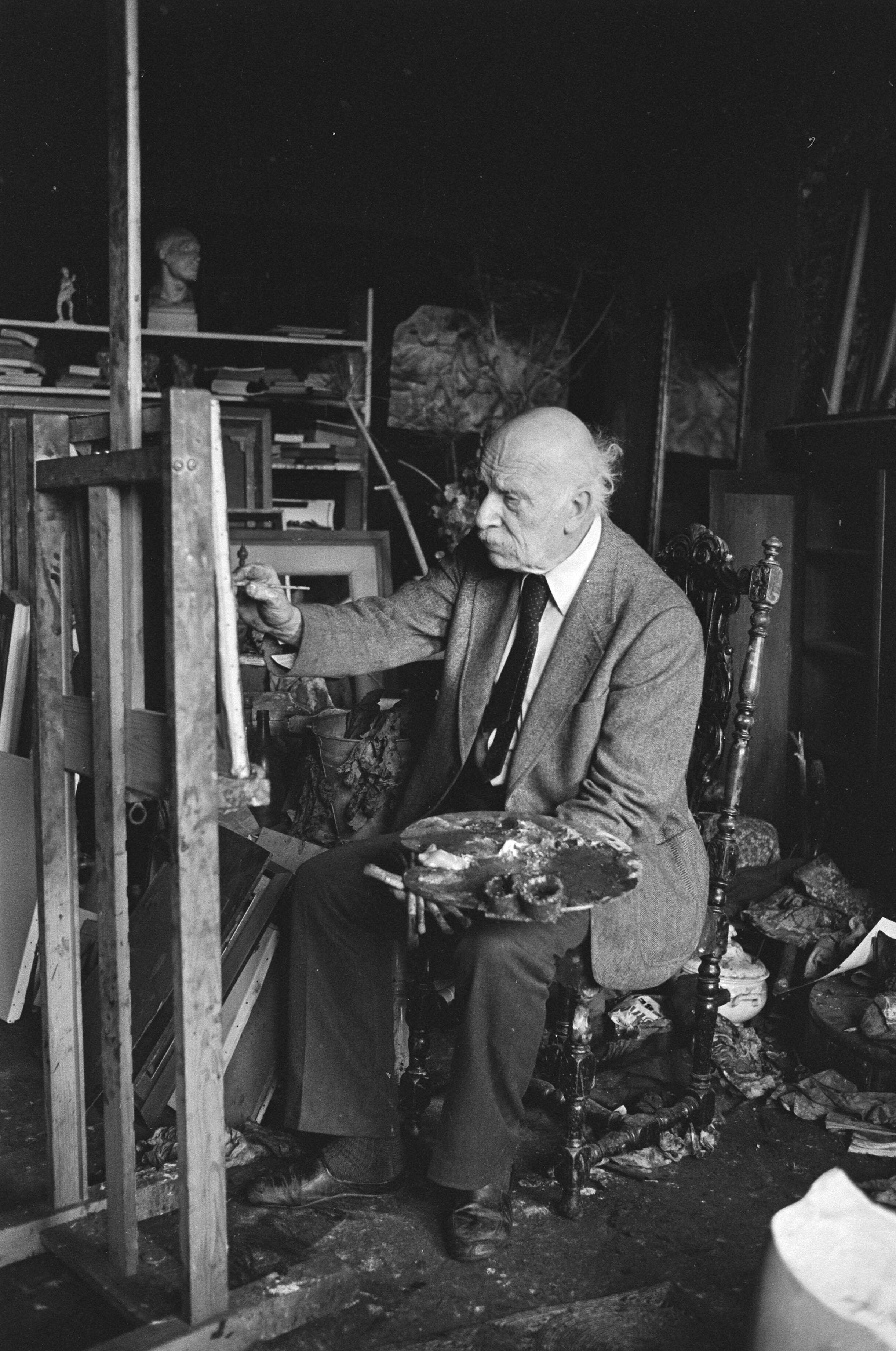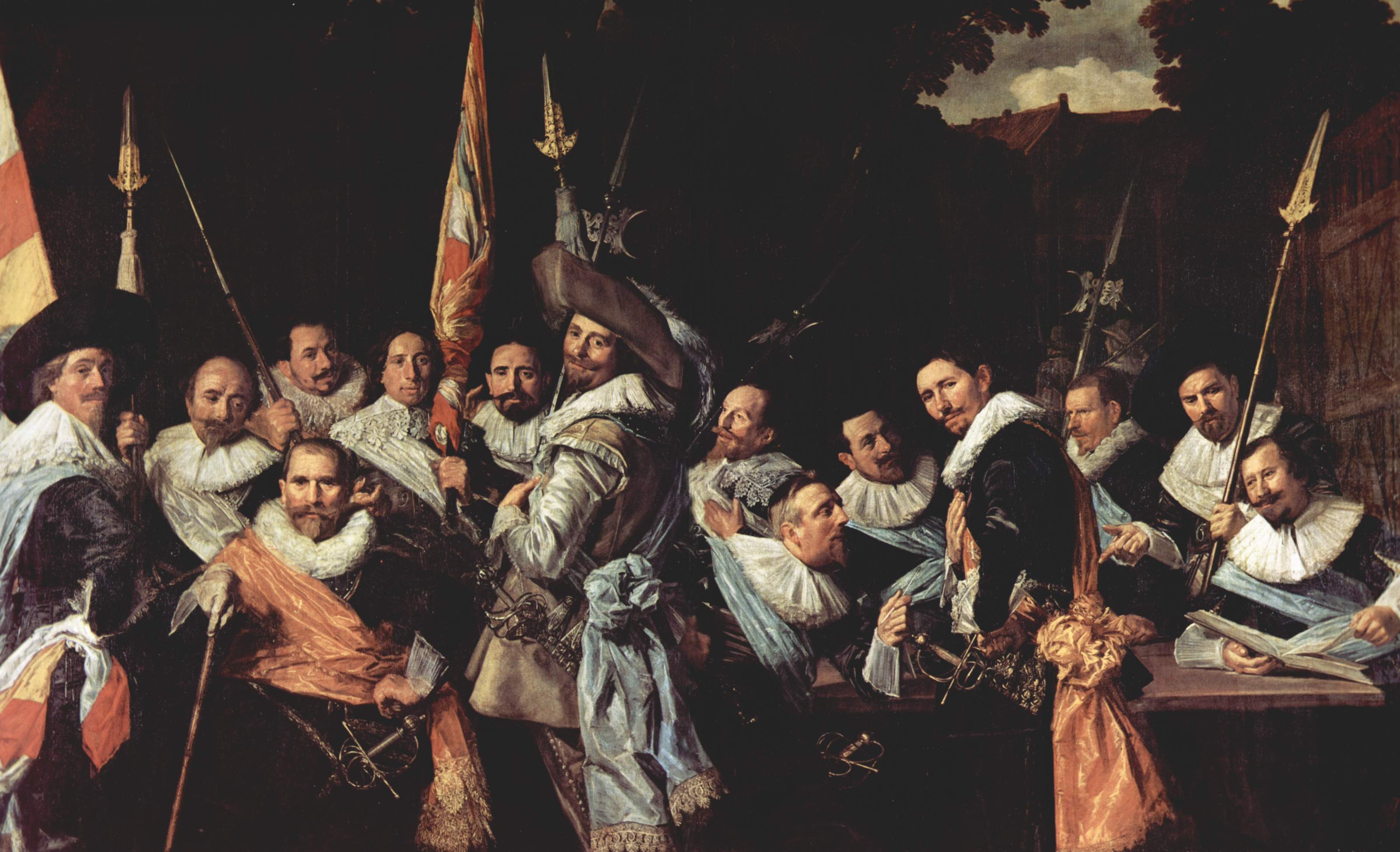|
Verweyhal
The Verweyhal is an exhibition space next to the Vleeshal on the Grote Markt, Haarlem. The Verweyhal was built in the 19th century as a gentlemen's society of the former drama society, later a cultural social club, Trou moet Blycken. In the second half of the 19th century the earlier building of the drama society, which was on the same spot, was too small. In 1876 the society held a competition for a new design. The Amsterdam architect A.J. van Beek won, and his plan was carried out with the help of local builder A. Raasveld.Rijksmonument report The building was occupied in 1880. The building is in the Eclectic style that was very popular at the end of the 19th century in Haarlem, but later fell out of fashion. In the first half of the 20th century, the building received a great deal of criticism. It was considered much too large and pompous. ‘An object of general contempt,’ according to the description of the distinguished gentlemen's society. Almost immediately, the gentlem ... [...More Info...] [...Related Items...] OR: [Wikipedia] [Google] [Baidu] |
Museum De Hallen, Haarlem
Frans Hals Museum - Hal (until March 29 2018: ''De Hallen Haarlem'') is one of the two locations of the Frans Hals Museum, located on the Grote Markt, Haarlem, Netherlands, where modern and contemporary art is on display in alternating presentations. The emphasis is on contemporary photograph and video presentations, with the focus on Man and society. The museum consists of three different buildings, the Vleeshal (Flesher's hall) on the east side and the Verweyhal (named for Kees Verwey) on the west side are two large "halls" sandwiching the small entrance building. All three buildings are National Heritage sites today.Rijksmonument report De Vleeshal building The Vleeshal was built in the years 1602 to 1605 and was originally a ‘meat hall’ where butchers sold their goods. The heads of bulls and rams on the façades are reminders of the original function of the building. It is an example of Dutch Renaissance architecture, with Renaissance ornaments being applied on a ba ... [...More Info...] [...Related Items...] OR: [Wikipedia] [Google] [Baidu] |
Grote Markt, Haarlem
The Grote Markt is the central market square of Haarlem, Netherlands. According to the 1911 ''Encyclopædia Britannica''; Buildings of interest *Frans Hals Museum - Hal *Grote Kerk, Haarlem *Haarlem City Hall *Statue of Johann Costerus *Archaeological Museum of Haarlem *The Vleeshal *The Verweyhal The Verweyhal is an exhibition space next to the Vleeshal on the Grote Markt, Haarlem. The Verweyhal was built in the 19th century as a gentlemen's society of the former drama society, later a cultural social club, Trou moet Blycken. In the secon ... File:Haarlem - Stadhuis 1900.jpg, View across the market square towards the town hall in 1900 References {{1911, wstitle=Haarlem Streets in Haarlem Squares in the Netherlands ... [...More Info...] [...Related Items...] OR: [Wikipedia] [Google] [Baidu] |
Trou Moet Blycken
Trou Moet Blycken is a historical chamber of rhetoric over 500 years old and currently a gentlemen's club located in the middle of a busy shopping area on the Grote Houtstraat in Haarlem, Netherlands. History Though the society probably goes back earlier in time, the earliest document from the archives shows that it definitely was mentioned by name in 1503, so this has been historically used as the year of establishment, most recently for the 500 year anniversary in 2003.Website of Trou Moet Blycken This was not the only chamber of rhetoric in Haarlem; The Haarlem painters Job Adriaenszoon Berckheyde and Salomon de Bray were members of the chamber called 'De Wijngaardranken'. The club has kept most of its rich archive and paraphernalia and often collaborates with local institutions such as the Frans Hals Museum, the Historisch Museum Haarlem and the to display some of their rich cultural artifacts of theater life in Haarlem and of the broader low countries of the 17th-century. M ... [...More Info...] [...Related Items...] OR: [Wikipedia] [Google] [Baidu] |
Grote Houtstraat
The Grote Houtstraat is a shopping street in Haarlem that connects the Grote Markt to the Houtplein in the direction of the Haarlemmerhout woods. History The street runs along one of two old parallel roads running through the city on either side of the Grote Markt linking Heemstede to Schoten, and is one of the oldest streets in Haarlem. The Grote Houtstraat in Haarlem was originally just called the "Houtstraat" (Wood street) as it was the major road leading from the Grote Markt to the woods called the Haarlemmerhout.De straat waarin wij in Haarlem wonen; geschiedenis en verklaring der Haarlemse straatnamen, G. H. Kurtz, 1965 Until the 15th century it ended at what is today the , at that time the southern canal of the city. In the 15th century the town expanded southwards and the street was extended to the and a large town gate was placed near the bridge, which has since been torn down. Shopping street The street is lined with rijksmonuments such as the Verwey Hall, the Do ... [...More Info...] [...Related Items...] OR: [Wikipedia] [Google] [Baidu] |
Kees Verwey
Kees Verwey (April 20, 1900 – July 23, 1995) was a Dutch painter who was productive well into old age. Biography He was born in Amsterdam and was the nephew of the poet Albert Verwey and the architect Hendrik Petrus Berlage. According to the RKD he was a pupil of Henri Frédéric Boot, Johannes Hendricus Jurres, and Samuel Jessurun de Mesquita.Kees Verwey in the RKD He was heavily influenced by the Hague School and Impressionism. His big break came in 1931 when his work was exhibited along with that of other contemporary Haarlem artists (such as Hendrik van den Eijnde). The exhibition was held in the newly created Modern art gallery of the Frans Hals Museum located behind the main museum (today the gallery for the schutterstukken). He was a member of the Haarlem artist society "Kunst Zij Ons Doel", the "Kennemer Kunstenaarskring, and "Hollan ... [...More Info...] [...Related Items...] OR: [Wikipedia] [Google] [Baidu] |
Frans Hals Museum
The Frans Hals Museum is a museum located in Haarlem, the Netherlands. The museum was established in 1862. In 1950, the museum was split in two locations when the collection of modern art was moved to the '' Museum De Hallen'' (since 2018 called ''Hal)''. The main collection, including its famous 17th-century Frans Hals paintings, for which the museum is named, is located in the former ''Oude Mannenhuis'' on the Groot Heiligland. The museum was founded in 1862 in the newly renovated former Dominican church cloisters located in the back of the Haarlem city hall known as the ''Prinsenhof'', and when it needed more space, it moved to the recently vacated location of the town orphanage in 1913. The collection is based on the large number of paintings owned by the City of Haarlem, which includes over 100 artworks seized from Catholic churches in the 1580s after the Protestant Reformation, and Haarlem art rescued from demolished local buildings from the 15th century onwards. In 2018 t ... [...More Info...] [...Related Items...] OR: [Wikipedia] [Google] [Baidu] |
Vleeshal
The Vleeshal is a historical building dating from 1603 on the Grote Markt in Haarlem, the Netherlands. History ''Vleeshal'' means meat-hall; it was the only place in Haarlem where fresh meat was allowed to be sold from 1604 to the 18th century. The ox-heads on the front of the building indicate the function of the hall. The building was used for selling fresh meat; salted meat was sold in the Warmoesstraat, the street next to the building. It was designed in renaissance style by Lieven de Key. It was built from 1602 to 1603. Before that there was already a small Vleeshal on the crossing of the Spekstraat and the Warmoesstraat, but around 1600 it had become too small, and the meat had to be sold outside. The new building was a prestigious project; expensive materials and a beautiful design were used. It opened on November 1, 1604. There was room for 40 different meat merchants in the building. The building was in use as meat-hall until 1840. Afterwards it was used by the Nationa ... [...More Info...] [...Related Items...] OR: [Wikipedia] [Google] [Baidu] |
Amsterdam
Amsterdam ( , , , lit. ''The Dam on the River Amstel'') is the Capital of the Netherlands, capital and Municipalities of the Netherlands, most populous city of the Netherlands, with The Hague being the seat of government. It has a population of 907,976 within the city proper, 1,558,755 in the City Region of Amsterdam, urban area and 2,480,394 in the Amsterdam metropolitan area, metropolitan area. Located in the Provinces of the Netherlands, Dutch province of North Holland, Amsterdam is colloquially referred to as the "Venice of the North", for its large number of canals, now designated a World Heritage Site, UNESCO World Heritage Site. Amsterdam was founded at the mouth of the Amstel River that was dammed to control flooding; the city's name derives from the Amstel dam. Originally a small fishing village in the late 12th century, Amsterdam became a major world port during the Dutch Golden Age of the 17th century, when the Netherlands was an economic powerhouse. Amsterdam is th ... [...More Info...] [...Related Items...] OR: [Wikipedia] [Google] [Baidu] |
Guilder
Guilder is the English translation of the Dutch and German ''gulden'', originally shortened from Middle High German ''guldin pfenninc'' "gold penny". This was the term that became current in the southern and western parts of the Holy Roman Empire for the Fiorino d'oro (introduced in 1252). Hence, the name has often been interchangeable with ''florin'' ( currency sign ''ƒ'' or ''fl.''). The guilder is also the name of several currencies used in Europe and the former colonies of the Dutch Empire. Gold guilder The guilder or gulden was the name of several gold coins used during the Holy Roman Empire. It first referred to the Italian gold florin introduced in the 13th century. It then referred to the Rhenish gulden (florenus Rheni) issued by several states of the Holy Roman Empire from the 14th century. The Rhenish gulden was issued by Trier, Cologne and Mainz in the 14th and 15th centuries. Basel minted its own ''Apfelgulden'' between 1429 and 1509. Bern and Solothurn followed i ... [...More Info...] [...Related Items...] OR: [Wikipedia] [Google] [Baidu] |
Kees Verwey Foundation
{{disambiguation ...
Kees or KEES may refer to: * Kees (given name) * Kees (surname) * KEES, an American AM radio station licensed to Gladewater, Texas See also * Cees (other) Cees () is a Dutch masculine given name, a short form of Cornelis. Since, as in English, the letter "c" before "e" is normally pronounced in Dutch, the alternative spelling Kees is more common. Notable people named Cees include: * Cees Andries ... [...More Info...] [...Related Items...] OR: [Wikipedia] [Google] [Baidu] |
Wiek Röling
Wiek may refer to: *the old German name for Lääne County, Estonia *a common German dialect name for bays on the coast of Pomerania *Wiek, Rügen, a municipality on the island of Rügen, Germany * WIEK-LD, a defunct low-power television station (channel 23) formerly licensed to serve Midland, Michigan Midland is a city in and the county seat of Midland County, Michigan. The city's population was 42,547 as of the 2020 census. It is the principal city of the Midland Micropolitan Statistical Area, part of the larger Saginaw-Midland-Bay City Comb ..., United States See also * Wieck (other) * Wyk (other) * Wick (other) {{Disambiguation, geo, callsign ... [...More Info...] [...Related Items...] OR: [Wikipedia] [Google] [Baidu] |







.jpg)
